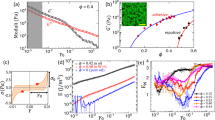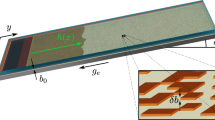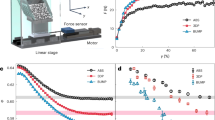Abstract
A fundamental challenge regarding disordered solids is predicting macroscopic yield—the point at which elastic behaviour changes to plastic behaviour—from the microscopic arrangements of constituent particles. Yield is accompanied by a sudden and large increase in energy dissipation due to the onset of plastic rearrangements. This suggests that one path to understanding bulk rheology is to map particle configurations to their mode of deformation. Here, we subject two-dimensional dense colloidal systems to oscillatory shear, measure the particle trajectories and bulk rheology, and quantify particle microstructure using excess entropy. Our results reveal a direct relation between excess entropy and energy dissipation that is insensitive to the nature of interactions amongst particles. We use this relation to build a physically informed model that connects rheology to microstructure. Our findings suggest a framework for tailoring the rheological response of disordered materials by tuning microstructural properties.
This is a preview of subscription content, access via your institution
Access options
Access Nature and 54 other Nature Portfolio journals
Get Nature+, our best-value online-access subscription
$29.99 / 30 days
cancel any time
Subscribe to this journal
Receive 12 print issues and online access
$209.00 per year
only $17.42 per issue
Buy this article
- Purchase on Springer Link
- Instant access to full article PDF
Prices may be subject to local taxes which are calculated during checkout




Similar content being viewed by others
Data availability
Source data are provided with this paper. All data that support the plots within this paper and other findings of this study are available from the corresponding author upon reasonable request. Source data are provided with this paper.
References
Nagel, S. R. Experimental soft-matter science. Rev. Mod. Phys. 89, 025002 (2017).
Ioannidou, K. et al. Mesoscale texture of cement hydrates. Proc. Natl Acad. Sci. U. S. A. 113, 2029–2034 (2016).
Jerolmack, D. J. & Daniels, K. E. Viewing Earth’s surface as a soft-matter landscape. Nat. Rev. Phys. 1, 716–730 (2019).
Nie, S., Jiang, Q., Cui, L. & Zhang, C. Investigation on solid–liquid transition of soft mud under steady and oscillatory shear loads. Sediment. Geol. 397, 105570 (2020).
Falk, M. L. & Langer, J. S. Dynamics of viscoplastic deformation in amorphous solids. Phys. Rev. E 57, 7192–7205 (1998).
Buttinoni, I. et al. Colloidal polycrystalline monolayers under oscillatory shear. Phys. Rev. E 95, 012610 (2017).
Guazzelli, l & Pouliquen, O. Rheology of dense granular suspensions. J. Fluid Mech. 852, P1 (2018).
Cipelletti, L., Martens, K. & Ramos, L. Microscopic precursors of failure in soft matter. Soft Matter 16, 82–93 (2020).
Richard, D. et al. Predicting plasticity in disordered solids from structural indicators. Phys. Rev. Mater. 4, 113609 (2020).
Galloway, K. L. et al. Scaling of relaxation and excess entropy in plastically deformed amorphous solids. Proc. Natl Acad. Sci. U. S. A. 117, 11887–11893 (2020).
Ingebrigtsen, T. S. & Tanaka, H. Structural predictor for nonlinear sheared dynamics in simple glass-forming liquids. Proc. Natl Acad. Sci. U. S. A. 115, 87–92 (2018).
Bonnecaze, R. T., Khabaz, F., Mohan, L. & Cloitre, M. Excess entropy scaling for soft particle glasses. J. Rheol. 64, 423–431 (2020).
Dyre, J. C. Perspective: excess-entropy scaling. J. Chem. Phys. 149, 210901 (2018).
Separdar, L., Bailey, N. P., Schrøder, T. B., Davatolhagh, S. & Dyre, J. C. Isomorph invariance of couette shear flows simulated by the sllod equations of motion. J. Chem. Phys. 138, 154505 (2013).
Xia, X. & Wolynes, P. G. Fragilities of liquids predicted from the random first order transition theory of glasses. Proc. Natl Acad. Sci. U. S. A. 97, 2990–2994 (2000).
Hallett, J. E., Turci, F. & Royall, C. P. Local structure in deeply supercooled liquids exhibits growing lengthscales and dynamical correlations. Nat. Commun. 9, 1–10 (2018).
Argon, A. Plastic deformation in metallic glasses. Acta Metal. 27, 47 – 58 (1979).
Siebenbürger, M., Fuchs, M., Winter, H. & Ballauff, M. Viscoelasticity and shear flow of concentrated, noncrystallizing colloidal suspensions: comparison with mode-coupling theory. J. Rheol. 53, 707–726 (2009).
Slotterback, S. et al. Onset of irreversibility in cyclic shear of granular packings. Phys. Rev. E 85, 021309 (2012).
Cubuk, E. D. et al. Structure-property relationships from universal signatures of plasticity in disordered solids. Science 358, 1033–1037 (2017).
Chen, K. et al. Low-frequency vibrations of soft colloidal glasses. Phys. Rev. Lett. 105, 025501 (2010).
Xu, N., Wyart, M., Liu, A. J. & Nagel, S. R. Excess vibrational modes and the boson peak in model glasses. Phys. Rev. Lett. 98, 175502 (2007).
Patinet, S., Vandembroucq, D. & Falk, M. L. Connecting local yield stresses with plastic activity in amorphous solids. Phys. Rev. Lett. 117, 045501 (2016).
Patinet, S., Barbot, A., Lerbinger, M., Vandembroucq, D. & Lemaitre, A. Origin of the Bauschinger effect in amorphous solids. Phys. Rev. Lett. 124, 205503 (2020).
Maestro, A. & Zaccone, A. Nonaffine deformation and tunable yielding of colloidal assemblies at the air–water interface. Nanoscale 9, 18343–18351 (2017).
Bouchbinder, E. & Langer, J. S. Shear-transformation-zone theory of linear glassy dynamics. Phys. Rev. E 83, 061503 (2011).
Keim, N. C. & Nagel, S. R. Generic transient memory formation in disordered systems with noise. Phys. Rev. Lett. 107, 010603 (2011).
Mukherji, S., Kandula, N., Sood, A. & Ganapathy, R. Strength of mechanical memories is maximal at the yield point of a soft glass. Phys. Rev. Lett. https://doi.org/10.1103/PhysRevLett.122.158001 (2019).
Pashine, N., Hexner, D., Liu, A. J. & Nagel, S. R. Directed aging, memory, and nature’s greed. Sci. Adv. https://advances.sciencemag.org/content/5/12/eaax4215.full.pdf (2019).
Keim, N. C., Hass, J., Kroger, B. & Wieker, D. Global memory from local hysteresis in an amorphous solid. Phys. Rev. Res. 2, 012004 (2020).
Gadala-Maria, F. & Acrivos, A. Shear-induced structure in a concentrated suspension of solid spheres. J. Rheol. 24, 799–814 (1980).
Keim, N. C., Paulsen, J. D. & Nagel, S. R. Multiple transient memories in sheared suspensions: robustness, structure, and routes to plasticity. Phys. Rev. E 88, 032306 (2013).
Keim, N. C. & Arratia, P. E. Yielding and microstructure in a 2d jammed material under shear deformation. Soft Matter 9, 6222–6225 (2013).
Teich, E. G., Galloway, K. L., Arratia, P. E. & Bassett, D. S. Crystalline shielding mitigates structural rearrangement and localizes memory in jammed systems under oscillatory shear. Sci. Adv. https://advances.sciencemag.org/content/7/20/eabe3392.full.pdf (2021).
Keim, N. C. & Arratia, P. E. Mechanical and microscopic properties of the reversible plastic regime in a 2D jammed material. Phys. Rev. Lett. 112, 028302 (2014).
Lundberg, M., Krishan, K., Xu, N., O’Hern, C. S. & Dennin, M. Reversible plastic events in amorphous materials. Phys. Rev. E 77, 041505 (2008).
Möbius, R. & Heussinger, C. (ir)reversibility in dense granular systems driven by oscillating forces. Soft Matter 10, 4806–4812 (2014).
Regev, I., Lookman, T. & Reichhardt, C. Onset of irreversibility and chaos in amorphous solids under periodic shear. Phys. Rev. E 88, 062401 (2013).
van Hecke, M. Jamming of soft particles: geometry, mechanics, scaling and isostaticity. J. Phys. Condens. 22, 033101 (2009).
Behringer, R. & Chakraborty, B. The physics of jamming for granular materials: a review. Rep. Prog. Phys. 82, 012601 (2018).
Liu, A. J. & Nagel, S. R. The jamming transition and the marginally jammed solid. Annu. Rev. Condens. Matter Phys. 1, 347–369 (2010).
Martinez, L. & Angell, C. A. A thermodynamic connection to the fragility of glass-forming liquids. Nature 410, 663–667 (2001).
Vermant, J. & Solomon, M. J. Flow-induced structure in colloidal suspensions. J. Phys. Condens. 17, R187–R216 (2005).
Cheng, X., McCoy, J. H., Israelachvili, J. N. & Cohen, I. Imaging the microscopic structure of shear thinning and thickening colloidal suspensions. Science 333, 1276–1279 (2011).
Seth, J. R., Mohan, L., Locatelli-Champagne, C., Cloitre, M. & Bonnecaze, R. T. A micromechanical model to predict the flow of soft particle glasses. Nat. Mater. 10, 838–843 (2011).
Parsi, F. & Gadala-Maria, F. Fore-and-aft asymmetry in a concentrated suspension of solid spheres. J. Rheol. 31, 725–732 (1987).
Dudowicz, J., Freed, K. F. & Douglas, J. F. Generalized Entropy Theory of Polymer Glass Formation (Wiley, 2007).
Bi, D., Henkes, S., Daniels, K. E. & Chakraborty, B. The statistical physics of athermal materials. Annu. Rev. Condens. Matter Phys. 6, 63–83 (2015).
Ono, I. K. et al. Effective temperatures of a driven system near jamming. Phys. Rev. Lett. 89, 095703 (2002).
Khabaz, F. & Bonnecaze, R. T. Thermodynamics of shear-induced phase transition of polydisperse soft particle glasses. Phys. Fluids 33, 013315 (2021).
Shahin, G. The Stress Deformation Interfacial Rheometer. Ph.D. thesis, University of Pennsylvania (1986).
Brooks, C. F., Fuller, G. G., Frank, C. W. & Robertson, C. R. An interfacial stress rheometer to study rheological transitions in monolayers at the air/water interface. Langmuir 15, 2450–2459 (1999).
Reynaert, S., Brooks, C. F., Moldenaers, P., Vermant, J. & Fuller, G. G. Analysis of the magnetic rod interfacial stress rheometer. J. Rheol. 52, 261–285 (2008).
Aveyard, R., Clint, J. H., Nees, D. & Paunov, V. N. Compression and structure of monolayers of charged latex particles at air/water and octane/water interfaces. Langmuir 16, 1969–1979 (2000).
Masschaele, K., Park, B. J., Furst, E. M., Fransaer, J. & Vermant, J. Finite ion-size effects dominate the interaction between charged colloidal particles at an oil–water interface. Phys. Rev. Lett. 105, 048303 (2010).
Park, B. J., Vermant, J. & Furst, E. M. Heterogeneity of the electrostatic repulsion between colloids at the oil–water interface. Soft Matter 6, 5327–5333 (2010).
Keim, N. C. & Arratia, P. E. Role of disorder in finite-amplitude shear of a 2D jammed material. Soft Matter 11, 1539–1546 (2015).
Larson, R. The Structure and Rheology of Complex Fluids (Oxford Univ. Press, 2010).
Baranyai, A. & Evans, D. J. Direct entropy calculation from computer simulation of liquids. Phys. Rev. A 40, 3817–3822 (1989).
Plimpton, S. Fast Parallel Algorithms for Short-Range Molecular Dynamics (Sandia National Labs, 1993).
Widom, M., Strandburg, K. J. & Swendsen, R. H. Quasicrystal equilibrium state. Phys. Rev. Lett. 58, 706 (1987).
Glaser, J. et al. Strong scaling of general-purpose molecular dynamics simulations on gpus. Comput. Phys. Commun. 192, 97–107 (2015).
Anderson, J. A., C. D., L. & Travesset, A. General purpose molecular dynamics simulations fully implemented on graphics processing units. J. Comput. Phys. 227, 5342–5359 (2008).
Bitzek, E., Koskinen, P., Gähler, F., Moseler, M. & Gumbsch, P. Structural relaxation made simple. Phys. Rev. Lett. 97, 170201 (2006).
Acknowledgements
We thank D. Durian, A. Liu, R. Riggleman, I. Regev and S. Kosgodagan Acharige for fruitful discussions. We especially thank A. Liu and R. Riggleman for the generous contribution of computational resources for our simulations. This work is partially funded by University of Pennsylvania’s MRSEC NSF-DMR-1720530 (K.L.G., E.G.T., X.G.M., Ch.K., I.R.G., D.J.J., A.G.Y. and P.E.A.) and by ARO W911-NF-16-1-0290 (K.L.G., D.J.J. and P.E.A.) and by NSF-DMR-2003659 (A.G.Y., X.G.M.). C.R. further thanks the NSF for career award CMMI-2047506.
Author information
Authors and Affiliations
Contributions
D.J.J., A.G.Y. and P.E.A. designed the research. K.L.G. and N.C.K. conducted the experiments. Ch.K. and I.R.G. ran the simulations. The analysis and model were developed by K.L.G., C.R., X.G.M., A.G.Y. and P.E.A. All authors discussed the results and wrote the manuscript.
Corresponding author
Ethics declarations
Competing interests
The authors declare no competing interests.
Peer review
Peer review information
Nature Physics thanks Francesco Turci and the other, anonymous, reviewer(s) for their contribution to the peer review of this work.
Additional information
Publisher’s note Springer Nature remains neutral with regard to jurisdictional claims in published maps and institutional affiliations.
Supplementary information
Supplementary Information
Supplementary materials
Supplementary Video
Radial distribution function, g(x,y,t), accompanying Fig. 2a.
Source data
Source Data Fig. 1
Data accompanying Fig. 1
Source Data Fig. 2
Data accompanying Fig. 2
Source Data Fig. 3
Data accompanying Fig. 3
Source Data Fig. 4
Data accompanying Fig. 4
Rights and permissions
About this article
Cite this article
Galloway, K.L., Teich, E.G., Ma, X.G. et al. Relationships between structure, memory and flow in sheared disordered materials. Nat. Phys. 18, 565–570 (2022). https://doi.org/10.1038/s41567-022-01536-9
Received:
Accepted:
Published:
Issue Date:
DOI: https://doi.org/10.1038/s41567-022-01536-9



